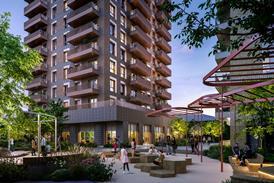Labour’s housebuilding plan must prioritise sustainable transport for future generations, writes Christopher Martin

We have now all seen and reflected on the Labour Government’s plans to build more across the UK. We have seen compulsory housebuilding targets for local councils reinstated, in an effort to build 1.5 million new homes in the next five years. We have also been promised reform in the planning system to make it easier to build these homes, including on the ‘grey belt’, as we’ve come to know it.
The one addition to the NPPF I am most interested in, as a transport and urban design specialist of over 19 years, is the promotion of a vision led approach to promoting sustainable transport for new developments. This is underlined elsewhere in the discussion, saying that well designed development means it has to be in the right place. These pledges could lead to 1.5 million new homes, but without consideration of sustainable transport, this development could well create more problems and come into conflict with Labour’s other goals.
Where development is located is one part of how we avoid kicking this crisis can down the road. How we shape transport and streets in and around new neighbourhoods is equally critical. In the past we have demonstrated our ability to consistently deliver developments that are car dependant and are not walkable. We have consistently delivered neighbourhoods where streets do not connect up, unless you’re driving. The way you connect to your neighbourhood and move around it is governed first and foremost by the needs of bin lorries, servicing, and space for cars, not spaces for people.
New neighbourhoods need to be built centred around walking and wheeling, with compelling and easy connections to sustainable transport like the recently announced Phoenix development in Lewes. Here, the neighbourhood channels vehicles to the southern tip of the area, creating streets safe for walking, cycling, and for children playing, with space that we have elsewhere traditionally used for private driveways instead being put to communal use as shared courtyards, playgrounds, and green infrastructure.
Labour has outlined ‘five missions to rebuild Britain’ and how we use the power of transport in building these new homes is critical to their delivery or failure.
We need a formal coupling of transport and housing – structurally in the planning system and procedurally within the design process
Kickstarting economic growth. Focussing new development on walking and active and sustainable modes is evidenced to deliver on this. Living Streets’ excellent Pedestrian Pound demonstrates that people places make more money, and walking and cycling-led transport has very high returns for taxpayers’ money, at £5.62 for each £1 spent – double the returns of vehicle traffic streets.
Take back our streets. Transport Secretary Louise Haigh has said that transport is essential for delivering safer streets, safety on public transport networks, and safety for women cycling down dark alleyways. Without smarter transport design we can’t do any of it. At Urban Movement we have been designing streets for the last 14 years that put people first and deliver against this mission. Recently, in Oxford, we transformed the historic Market Street from a relatively quiet and unused street, except by vehicles, into an inclusive destination that invites walking and cycling at all hours.
Break down barriers to opportunity. For decades, we have been building new neighbourhoods that force people into expensive car ownership to access opportunities, pushing some into transport poverty. Housebuilding should shatter transport poverty and connect people with opportunity without the need to invest in a private car.
Build an NHS fit for the future. Haigh has also highlighted that we’re in a public health crisis, and getting people walking, cycling, and moving more is essential to solving this in the immediate and long term. What’s more, she calls transport “a liberator,” something that can help government departments achieve their aims, including in education and health, rightly highlighting that it “has knock-on effects everywhere else: it gets people healthier, and it reduces the burden on the NHS because people are living healthier lives for longer.”
But we also shouldn’t ignore existing estates, neighbourhoods, streets, and transport infrastructure, which are essential to delivering the missions. If I am to believe that, with these new targets and NPPF changes, we have learned from the mistakes of the past and are committed to building 1.5 million homes the right way, then there’s no time to lose in sharing that commitment with people trapped in transport poverty because of where their home was built.
With almost three-quarters of trips in England being less than five miles, rather than committing to spend billions of pounds filling potholes, we need to be far smarter with road maintenance budgets. No street should ever just be resurfaced without first asking serious questions about what could be put back that would better deliver these missions while costing the same, and delivering for taxpayers’ money at twice the return.
We need a formal coupling of transport and housing – structurally in the planning system and procedurally within the design process – to ensure this investment and energy is truly transformational in tackling the huge range of issues and crises we have around the corner. Otherwise, it is business as usual: kicking the crises can down the overly wide road, stripping walkability from developments, and negatively affecting generations to come.
Postscript
Christopher Martin is an urban designer and strategic urban planner. He is co-founder of Urban Movement
















2 Readers' comments